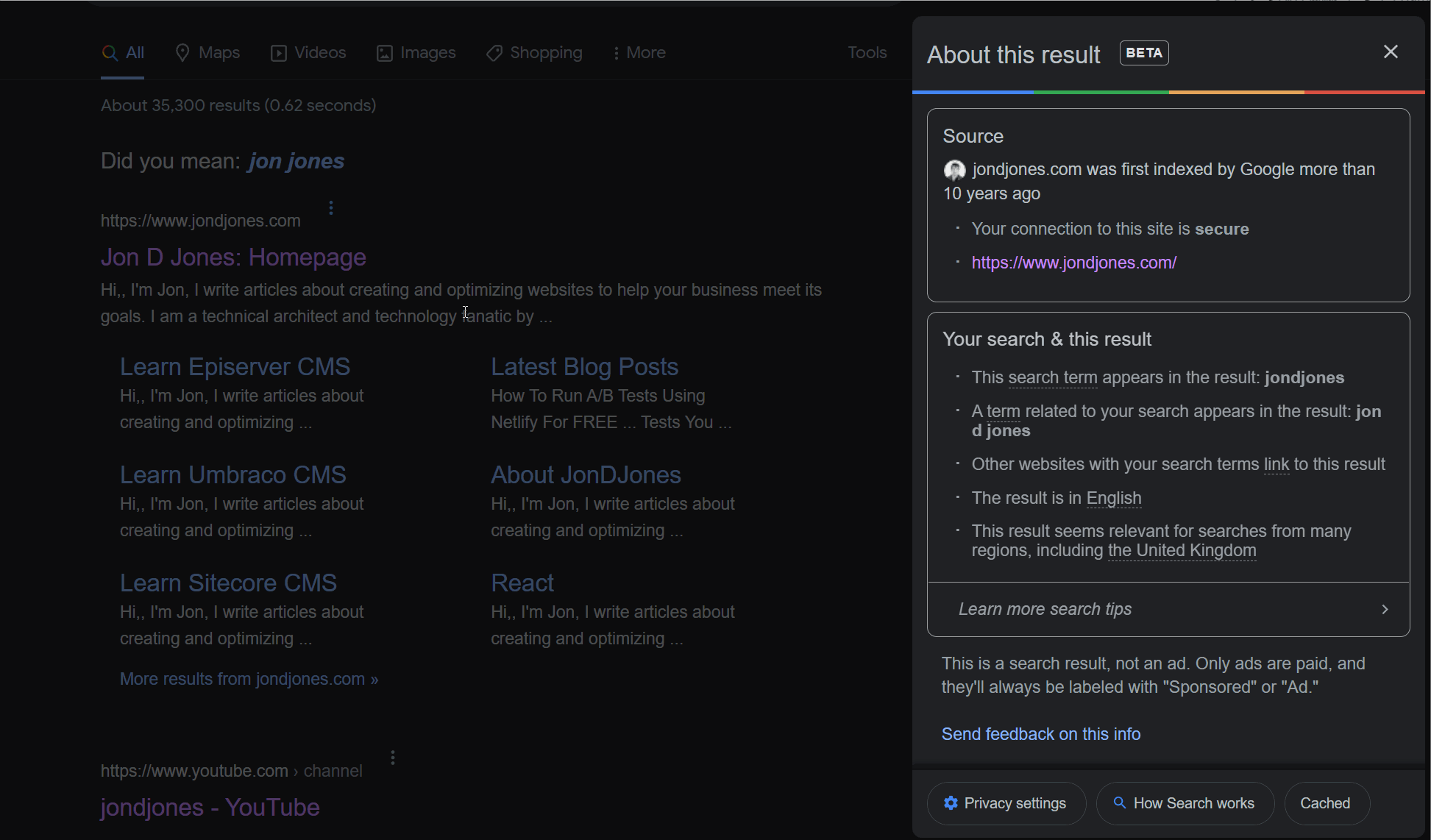On Thursday, October 14th 2021, I received an email alert from my website monitoring software... Monitor is DOWN: JDJ. I host this website using a shared hosting plan to save on the pennies. Dedicated hosting is great, however, it costs more 💸💸💸. When you decide to host your website using shared-hosting, the trade-off is that you pay less, however, your site will go down occasionally for server maintenance and updates.
On this Thursday evening, when I saw the website down notification, I thought big deal it will be up within 30 minutes. After a few hours, I had not received the usual website is backup notification, so I thought I would raise a support ticket to see what was going on. I was using MyAsp.net to host the site ( YES... I am happy to name and shame 🎤⤵️🖐 ). After logging a ticket within the support portal, I got an instant system alert that there was some strange issue and the company had severe server issues. There was no ETA on a fix or when my website might be available again. Two days later and several support tickets later, no reply. Eventually, I had a system message from MyAsp.Net that the database servers had issues, the company had lost my database and the backup servers were also corrupted, so my database was gone
Most of the features within their hosting portal didnt work and clicking on most of the buttons generated errors. FTP didnt work so I couldn't access any of my files to make any emergency remedial actions. There was nothing I could do to get my site working again. Eventually, on day 3, enough of their portal worked and I was able to create a new database, restore a backup of my main database that I had made a month previously and then edit my connection string via their portal. At 18:00 on October 17th, I finally saw the up-time monitor notification in my inbox that my website was working again. In total, my site was down for 73 hours and 58 minutes. During this time I had no advice from the support team, I still could not access the database, FTP did not work, and what was worse I had lost about 20 hours of content editing work.

The aim of this post is to not bash MyAsp.Net... although I am happy to 😡. Obviously, you need to be able to trust your hosting provider with your data. If a hosting specialist can't manage off-site back-ups then that's a company I cant work with. This is why I will move away from MyAsp.Net and I will never recommend them to anyone. Currently, they have offered me 18 months of free hosting, to compensate for my 20 hours of lost work. The rate I charge per hour is more than 18 months of hosting, so for me, my time is more precious than $50. This is the second time in a few years where this has happened with MyAsp.net. A few years ago, my website was down for many days as a hacker had got into their system and broken stuff. You can guess by the tone of my post today that I am no longer fan of their service. They seem a little bit cowboy and I would definitely not put any of my clients on their platform. I could have easily sorted off-site back-ups myself if I hosted my site within Azure with minimal knowledge, so lesson learnt
Unfortunately, my database had gone and so had my work. Instead of moping and around and crying, I took action to try and get back as much of my content as I could, but how? In this tutorial, I will talk you through all the steps and techniques I use to recover about 70% of my content. The best action for these situations is to prepare for them. With the right tools and processes. you can avoid having the same thing happen to your website. If you want to learn how to prevent yourself from losing 20 hours of work, read on 🔥🔥🔥.
Back-Up
Like the good little IT bod that I am, I did have a backup process for my site. I log in once a month to my hosting and back up my database and my media folder. As luck would have it, the server went down the day before my scheduled maintenance day. The reason why I had to rely on a manual backup process is that there was no way to automate the process in the MyAsp.Net portal. I did not realise this when I selected them as my provider. So this is my first bit of advice, being able to make your own automated back-ups is key when picking a hosting provider. If the hosting provider you are considering does not provide the ability to perform easy off-site back-ups as a service, choose someone else. As this situation proves, you can not trust your hosting provider to manage your data for you. It is your responsibility 🕸️🕸️🕸️
Finding Lost Data
My data was gone, however, was there a way I could get any of it back? This is where some free and easy pre-planning steps can really help you. I mainly use a Windows machine for development. There is a super-handy Clipboard manager called Ditto that I have been using for years. Ditto will store and archive any text that you add to the clipboard. Every time I create a new tutorial, I proofread it using a tool called Natural Readers. Natural Readers is a tool for dyslexic people like myself, who need a text to speech process to help them craft prose. Ditto stores everything it copies from the clipboard into a database. To try and get some of my lost content back, I went through my Ditto history. This worked and I managed to get about 10 hours of writing back. Unfortunately, I didn't have Ditto on every Pmachine that I write content on. So the second bit of advice is to use a clipboard manager and install it on every machine you use 📋.
Google Cache
Ditto helped me to recover some of my content, however, not all of it. For any public content you might lose, Google is your friend. Google has a cached' option. For any page that the Google crawler indexes, it keeps a makes a cached version as well. You can access this cached version via a browser easily. This cache will last for a good few days, but the cache will not last forever. So if you lose data you need to activate this step ASAP. Go into Google and selectcache`:

Go onto the page and copy what you can!
SEO Quake
If you have lost a lot of content, trying to remember the URLs for all those lost pages might be an impossible task. Google could reset its cache at any point, so you need to be quick in order to get your data out. This is where an extension called SEO Quake for Chrome can help. After installing SEO Quake, open the extension's preferences and make sure that the option called SERP overlay is enabled. Now search for your website in Google using this formatsite:mywebsite.com`. Within the SEO Quake modal, click on the “Export CSV” option. Depending on how many pages your site contains, you might want to make this task easier by increasing the maximum number of results Google returns. This is done from within Google search settings in the bottom left-hand corner of the screen. The maximum amount is 100 results per page!

Go through each result page in the report, view the cache and make a copy of that data!
Archive.org
If the Google search cache has refreshed, your last chance is the Wayback machine from Archive.org. Using your spreadsheet generated by SEO Quake, paste your URLs into the time machine and see what you can get. If you're lucky you can salvage some content this way as well.
Google Analytics
After following all these steps, if your content is gone for good then your focus should be on recovering your most popular pages first. This is where Google Analytics (or whatever analytics platform you use) can help. Using an analytics tool will allow you to create a list of your websites most popular pages and their URLs. This list can be generated from this page:
Behaviour ➡ Site Content ➡ All Pages
Prioritising all your most influential pages will mean that you will minimise the impact of all that amazing SEO mojo you spent ages creating 📉.
Have an Uptime Monitor
If you ever find yourself in the same situation as me, hopefully, these tips will help you recover some of your content. One vital point in this whole mess was knowing that my site was down instantly. I knew my site was down because I use a website monitoring tool. For those of you who are interested, I use Uptime Robot. Uptime Robot is great, it is free and does what you expect it to. I have been using it for years and I recommend that you give it a try 😁
I hope these tips help at least one person to minimise the amount of re-work they need to do. Re-writing lost content is a soul-destroying activity, so good luck! Happy Coding 🤘
